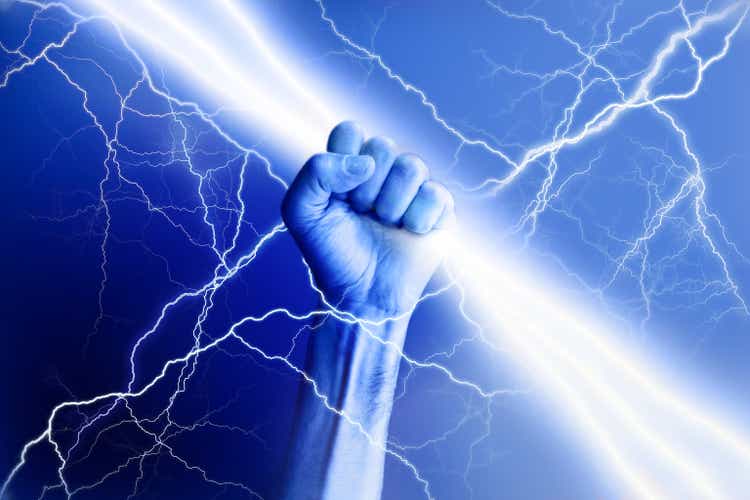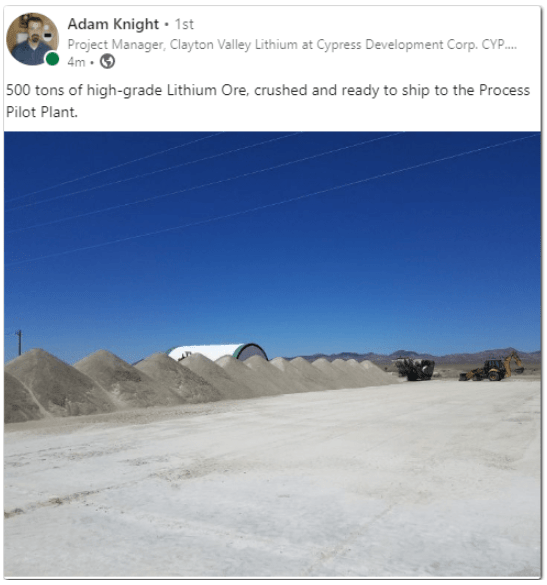vasiliki/E+ via Getty Images
The focus on this article is broken into two parts: First, we are going to take a broad overview of China and energy dominance; then we will shift to current US / Canadian policy concerning China and cover why bringing critical elements is crucial to U.S. energy independence from a strategic viewpoint.
In the second part, we will be reviewing U.S. based lithium-clay projects which have water rights and which are posed to prove that lithium can be extracted from clay. Lithium clay, once proven, could open the doors to increased institutional investment and lithium independence from foreign powers.
High Fuel Prices = More Electric Car Sales
This market is an odd one. I’ve been investing for over 31 years now and rarely is the market in a state of bliss. It is either too cold, too hot, too tepid and rarely just right. Yet, this market feels odd. It reminds me of 2007 leading into a 2008 event to some extent. Back then, we could all feel the glacially slow moving, but powerful problems probing the market. It took some time, but things got nasty, really nasty. That market did eventually recover, but it was a painful rollercoaster.
Just how bad can things get from a macro viewpoint? I think it could get pretty darn testy. Pick your poison. From the short-term view, we face rampant inflation, out of control oil prices, masses maxing out credit cards, and a looming food crisis due to drought and fertilizer supply issues. There is the Ukraine situation. Add in food production plants mysteriously catching fire left and right. To throw fuel on the fire, Libya is reporting it might cut oil output and the Biden administration is putting sanctions on Iran. Factor in a lack of oil refining capability and things are…askew.
| Sidebar: High fuel prices, however, will push more people into buying electric cars but (according to my local Volkswagen dealer) they are having two key problems: 1. Producing cars due to a chip shortage and 2. Taking delivery of cars due to a lack of truckdrivers. |
Yet, with all these troubles, one thing you can bet on is America overcoming problems due to abundant natural resources. While the U.S. has a plethora of such resources in the ground (such as lithium and cobalt), we remain at the mercy of foreign powers and long supply chains. Frankly, we mine too little and process even less. The U.S. needs to move the assets from the ground to active production and refining.
Yet, these high fuel prices that we are experiencing could push the adoption of EV at an accelerated rate. This could benefit the EV leader Tesla (TSLA) or the aspiring contenders such as Ford (F) or Volkswagen (OTCPK:VWAGY). Of course, increased EV sales equals increased use of lithium.
China & Energy Independence
While I disagreed with much of the policies of President Obama, one thing that I think he got right was shifting the focus of the U.S. military from small, never-ending regional wars to a peer or near-peer focus in the Pacific. Obama set the stage for exiting small thinking of “How do we contain insurgents or terrorist groups?” to “How do we fix the neglect of the Pacific and the military when it comes to conventional combat?”
While the military is retooling via better weapons (such as moving from the anemic 5.56mm to the arguably superior 6.8mm round) and the Marines are going back to their roots as a light, island-hopping force once again, China has not been idle in its energy aspirations. Indeed, China has been acquiring lithium assets in South America (such as Neo Lithium) and entering into joint ventures such as Lithium Americas (LAC) with its South American project. China realizes that lithium is the future. He who controls the lithium and lithium processing has a strategic as well as economic advantage.
While somewhat late to the game, it appears the U.S. and Canada are starting to smell the coffee. Various companies are moving battery production to the United States. Nano One (OTCPK:NNOMF) has acquired a small cathode plant in Canada. Concerning cobalt (a critical part of high-end electric cars), Electra Battery Materials (ELBM) is reopening a cobalt refinery and currently negotiating with the Canadian government to build a second cobalt refinery.
Past China Embargos
China has shown that it is not afraid to cut off the supply of REE (Rare Earth Elements) if need be. Such was the case in 2010 when China banned the export of REE to Japan. Warp forward from 2010 to 2022: China is becoming much more aggressive with Taiwan as evidenced by its flying of jets into Taiwan’s airspace on regular occurrences. If tensions were to worsen and/or if America were to take a hard stance, the possibility exists that China could cut off lithium and REE (including cobalt) to North America. This would have quite the impact on national defense (from fighter jets to hard drives). It would also affect EV automobiles as the vast majority of lithium (and cobalt) is mined overseas and then processed in China. The U.S. government (following much neglect) has now snapped to this fact and is currently taking measures to regain REE independence from China via funding of Lynas Rare Earths Texas project. Another company moving forward with REE is Texas Mineral Resources (OTCQB:TMRC) in conjunction with partner USA Rare Earth.
|
Side Bar: China was recently found to be posing as Texans in an effort to run a disinformation campaign to hinder construction of USA-based REE companies. Source: Americanmilitarynews.com and Defense.gov |
Trump’s Critical Elements List
While Obama set the stage for the military pivot to Asia, Trump altered the landscape via his “Critical Elements List” and subsequently Lithium Americas Thacker Pass lithium project got the green light from the BLM (Bureau of Land Management) in his final days. This put the U.S. Government on its initial path to lithium and REE independence from China, but we are only at the initial stages.
The Powers That Be
While a long time coming, the U.S. Government has taken notice of the problems of being dependent upon foreign powers for lithium energy independence. This has prompted several U.S. and Canadian government initiatives to fund lithium projects to the tune of hundreds of millions of dollars (with billions more to be had on the table).
Lithium Clay Validation
All of the above brings us to the present situation of lithium mines, processing, and battery production having come to America. All of the stars are starting to line up. Politicians are getting on board. The U.S. government and Canadian government are throwing billions in funding at the issue, and private funding has been quite active.
Realize that lithium mining comes primarily in flavors: Brine (water evaporation), rock-based lithium, and clay-based lithium. DLE (direct lithium extraction) also comes into play as a way to unlock trapped lithium.
One consideration that delays massive institutional investing in clay-based lithium is that, to some extent, clay is unproven. Brine-based lithium is very old and very well known. When looking at a brine project, stakeholders agree: brine has worked for a very long time. The same can be said of rock-based lithium extraction. Clay-based lithium, however, is the new kid on the block. Test amounts of clay-based lithium have been produced: We have yet to see mass commercialization. Lithium Americas via Thacker Pass and Cypress Development (OTCQB:CYDVF) via Clayton Valley both lead the way on lithium clays. Albemarle (ALB) has also expressed interest in clay-based lithium.
Considering the larger strategic view, the United States must increase domestic lithium production. While Albemarle is not the most aggressive lithium company, they are expanding operations. In January of 2021, Albemarle announced they were looking at clay-based lithium in Clayton Valley, while also committing to print they were going to double production at Silver Peak. How they intend to increase production might lead to some interesting speculations involving Clayton Valley.
Recent News for Two Clay Contenders
Once clay-based lithium is proven valid, the financial doors will open to increased investments in lithium clays (assuming the stock market is favorable). Some recent news for clay-based lithium includes:
Lithium Americas Thacker Pass: is moving forward with the legal case involving the Bureau of Land Management (BLM) and various environmentalist groups. A recent proposal of sanctions was denied by Judge Du. While minor, this is a positive event in the legal case. The legal case, however, continues to slip. Judge Du had wanted to wrap up the case for the construction season. Recent comments, though, make me suspect this will slip to winter of 2022 or spring of 2023. Lastly, LAC successfully defended its state-issued, water pollution control permit vs various lawyer groups.
Cypress Development: Continues to move forward with a new study (estimated completion is late 2022) that will incorporate higher lithium prices which should alter the NPV to a much higher number. A recent acquisition of neighboring Enertopia’s (OTCQB:ENRT) land will allow Cypress to expand the pit design. Additionally, Enertopia’s former land has had four holes drilled to verify data.
|
The main takeaway is to ponder how much the projects NPV will increase (given the data below) and how lithium prices have increased compared to when the older studies were conducted by Cypress.
|
Looking at the pilot plant, we see 500 tones of material is soon going to be ran though the facility.
500 tons of clay (LinkedIn via Cypress Development)
Investor Takeaway
While many great lithium plays exist (as well as some marginal ones), Cypress Development and Lithium Americas represent two of the better players. Each project has water rights. Each has its own unique set of risks as well, but the risk-to-reward makes sense if one is a patient investor.
It should not be presumed that each company is comparable to the other. They are not. Lithium Americas has a much larger market cap and a massive war chest of capital along with a project in Nevada and two projects in South America. LAC also has investments in Arena Minerals (OTCPK:AMRZF) and Green Technology Metals.
Cypress has a laser focus on Nevada and its clay project which borders Albemarle.
Risk
While I view the projects as having low risk, LAC does have some legal challenges in Nevada with the pending case. Macro view risk though is high. Inflation rages; the Fed really can’t raise rates too much without deep sixing the entire economy (not to mention servicing national debt interest rate payments if they raised rates too high). Supply chain issues are still here. Various companies are talking about laying off workers while other companies are cutting back on expansion plans. Everyone knows we are in an economic hurricane. The question is, does the hurricane go from a category 2 and ramp up to a category 5? Can present White House leadership guide the nation through the storm? We will see. Assuming an investor wants to keep bets in the market, the solution might just be to dollar-cost average and let the storm do its worst. Ride it out and wait for sunny days to return in a few years. 2007-2008 was a rough time but fair weather did return. The same might happen here with waters getting rougher but things smoothing out given time.


Be the first to comment